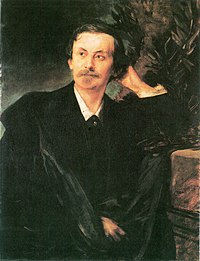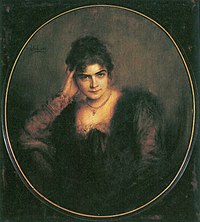Franz von Lenbach
Franz von Lenbach | |
|---|---|
 Self-portrait(1903) | |
| Born | 13 December 1836 |
| Died | 6 May 1904(aged 67) |
| Nationality | German |
| Known for | Painting |
Franz Seraph Lenbach,after 1882,Ritter von Lenbach(13 December 1836 – 6 May 1904), was a German painter known primarily for his portraits of prominent personalities from the nobility, the arts, and industry. Because of his standing in society, he was often referred to as the "Malerfürst" (Painter Prince).
Biography
[edit]His father, who originally came fromSouth Tyrolwhere the family name was spelled "Lempach", was a Master Mason forSchrobenhausen,[1][2]where Lenbach was born. Lenbach completed his primary education atLandsbergin 1848, then attended a business school inLandshut.From 1851 to 1852, he was apprenticed to the sculptorAnselm Sickingerin Munich. At that time, his father died and he went home to help in the family business.
He was only there a short time before beginning studies at theAugsburg University of Applied Sciences.While there, he drew and painted in his spare time, befriended Johann Baptist Hofner (1832–1913), the animal painter, and decided to become an artist. In 1854, he obtained his family's reluctant permission to study at theAcademy of Fine Arts, Munich,and later took private lessons fromHermann Anschütz.

Lenbach was already an accomplished artist when he became the pupil ofKarl von Piloty.[3]In 1858, he was able to stage an exhibition at theGlaspalastand won a travel scholarship, which enabled him to accompany Piloty to Rome. A few works remain as the outcome of this first journey:A Peasant seeking Shelter from Bad Weather(1855),The Goatherd(1860, in the Schack Gallery, Munich) andThe Arch of Titus(in the Palfy collection, Budapest).[3]He also travelled to Paris and Brussels. It was about then that he started receiving his first portrait commissions.
On returning toMunich,he was at once called toWeimarto take the appointment of professor[3]at the newly establishedWeimar Saxon Grand Ducal Art School,where he became known for taking his students on painting expeditions enplein aire.He remained for only two years, however, when he felt the need for more studies and decided to take another trip to Italy. During this time, he also found an important patron; BaronAdolf Friedrich von Schack.Through his support, Lenbach was able to leave for Italy in 1863 with a guaranteed annual income.

He returned to Munich in 1866. The following year, he won a gold medal at theExposition Universelleand went to Spain for one year, accompanied by his student,Ernst Friedrich von Liphart,[4]to make more copies of theOld Mastersfor Schack.[5]Upon returning, his career as a portrait painter began in earnest. His breakthrough came in 1869, when he won a gold medal at the Glaspalast, despite being up against many fashionable French painters. After 1870, he began making visits to Vienna to develop a market for his paintings there, which even survived thePanic of 1873.It is also said that he travelled there frequently because he had a passion forMaria Beccadelli di Bologna,which was never returned.
From 1875 to 1876 he,Hans Makart,and other associates made a trip to Egypt, which left a deep impression in his style. In 1882, he was awarded theOrder of Merit of the Bavarian Crown,which entitled him to become "Von Lenbach". The following year, he was back in Rome, where he lived in apartments at thePalazzo Borghese.One of his sitters wasClara Schumann,whose portrait he drew in pastel in 1878.[6]In 1885, he was commissioned to do a portrait ofPope Leo XIII.As the Pope did not have time to sit for the portrait, a new technique was used to create a photographic template. He left Rome in 1887 and began building a villa in Munich. Later that year, he married Countess MagdalenaMoltke.

By the 1890s, he was painting almost entirely from photographs, a common practice at the time, but he also began working too fast, in an effort to create sufficient income. In 1895, a major scandal erupted when one of his assistants took unfinished paintings and sketches, had students fill in the details, and passed them off as Lenbach's work. In 1896, he and Magdalena were divorced, over suspicions of infidelity with her doctor,Ernst Schweninger,whom she did in fact later marry. Lenbach also remarried, to Charlotte von Hornstein, daughter of the composerRobert von Hornstein.
He refused to join theMunich Secessionand was highly critical of the newBavarian National Museum.He also began to paint women, almost exclusively, whereas before he had concentrated on men. Around 1900, he started to producetrading carddesigns for theStollwerckchocolate company of Cologne.
In 1902, he became an honorary Knight in theLégion d’Honneur.That same year, he suffered a stroke while returning from a trip to his home town and never fully recovered. He died at hisMunichvilla two years later. He was buried at theWestfriedhofand many prominent figures spoke at his funeral.
Legacy
[edit]
Some of Lenbach's paintings are now in national collections in the United Kingdom, including portraits by Lenbach ofBismarckandGladstonein theNational Galleries of Scotlandand another of Gladstone in thePalace of Westminster.[7]Others are in theFrye Art Museumin Seattle, Washington.[8]
Third Reich era
[edit]Lenbach's paintings were much prized by topNazisand given as gifts by underlings.GoebbelsgiftedHitlera Lenbach in 1936, writing in his diary, "(Hitler) is very touched and takes the greatest joy in my Lenbach".[9]Lenbachs were also looted from Jewish collectors like the Löw-Beer family inBrněnec,[10]Rudolf MosseinBerlin,[11]Sigmund Bernstein,[12]and many others. The database of the German Lost Art Foundation lists 108 entries for Lenbach.[13]The ERR database for objects seized in France (the "Cultural Plunder by theEinsatzstab Reichsleiter Rosenberg:Database of Art Objects at theJeu de Paume") lists six artworks by Lenbach.[14]
See also
[edit]References
[edit]- ^"ahnen.ubuecher.de: Franz Joseph Lenbach + Josepha Herke".Archived fromthe originalon 4 March 2016.Retrieved14 April2017.
- ^online-ofb.de Josepha Herke
- ^abcChisholm, Hugh,ed. (1911)..Encyclopædia Britannica.Vol. 16 (11th ed.). Cambridge University Press. pp. 417–418.
- ^Baron Ernst Friedrich von Liphart,RusArtNet, retrieved 31 December 2013
- ^Ernst Friederich von Liphart,Master Paintings, retrieved 3 January 2014
- ^Reich, Nancy B. (1985).Clara Schumann: The Artist and the Woman.Ithaca u.a: Cornell Univ. Pr. p. 165.ISBN9780801493881.
- ^7 artworks by or after Franz von Lenbachat theArt UKsite
- ^Charles and Emma Frye CollectionArchived2015-01-17 at theWayback Machine,Frye Museum, retrieved 5 February 2014
- ^"Spoils of War"(PDF).p. 32.
Hitler, of course, emerged as the prime beneficiary. The presents given to him each April 20, on his birthday constituted an important means of expanding his collection. Examples include Goebbels presentation of a Lenbach painting in 1936 (which he described in his diary: "(Hitler) is very touched and takes the greatest joy in my Lenbach" )
- ^"Holocaust_Era_Assets_Conference_Proceedings_2009"(PDF).p. 861.
- ^"German groups, Jewish heirs unite efforts to locate lost art".lootedart.Retrieved2021-04-10.
Born in 1843, Mosse, who was part of the Jewish community that enjoyed success in Germany before the rise of the Nazis, was the publisher of the liberal daily Berliner Tageblatt and several other newspapers. He also owned about 130 trade magazines. His adopted daughter Felicia inherited a collection comprising thousands of paintings, sculptures, books, antiquities and furniture when Mosse died in 1920. Among Mosse's favourite artists were Max Liebermann, Oswald Achenbach, Franz Lenbach and Adolph Menzel. When the Nazis came to power in 1933, the family was forced to flee and their property was confiscated.
- ^"Nazis stehlen bei" Judenaktion "2000 Kunstwerke".lootedart.Welt Online.Retrieved2021-04-10.
Nach dem Krieg wurden viele Kunstwerke ausfindig gemacht. Sie waren in Central Collecting Points gebracht worden, auch aus dem Kloster Ettal, wo die Bestände der Pinakotheken eingelagert waren. Unter der Inventar-Nummer 161 war ein Lenbach-Porträt des Komponisten Franz von Liszt, es gehörte einst dem Sammler Sigmund Bernstein. Bis heute ist unklar, wo das Gemälde blieb.
- ^"Lost Art Internet Database - Advanced Search".lostart.de.Retrieved2021-04-10.
- ^"Cultural Plunder by the Einsatzstab Reichsleiter Rosenberg: Database of Art Objects at the Jeu de Paume".
Further reading
[edit]- Sonja von Baranow:Franz von Lenbach. Leben und Werk.DuMont, Cologne 1986,ISBN3-7701-1827-8.
- Reinhold Baumstark (Ed.):Lenbach. Sonnenbilder und Porträts.Pinakothek/DuMont, Munich 2004,ISBN3-8321-7409-5.
- Dieter Distl, Klaus Englert (Eds.), Reinhard Horn:Franz von Lenbach – Unbekanntes und Unveröffentlichtes.Ludwig, Pfaffenhofen 1986,ISBN3-7787-2080-5.
- Brigitte Gedon:Franz von Lenbach. Die Suche nach dem Spiegel.Nymphenburger, Munich 1999,ISBN978-3-485-00825-9;Überarb. Neuausg. DuMont, Köln 2011,ISBN3-8321-9410-X.
- Winfried Ranke:Franz von Lenbach. Der Münchner Malerfürst.Kiepenheuer & Witsch, Cologne 1986,ISBN3-462-01783-7.
External links
[edit] Media related toFranz von Lenbachat Wikimedia Commons
Media related toFranz von Lenbachat Wikimedia Commons- Paintings by Franz von Lenbach,list of works on Commons
- Literature by and about Franz von Lenbachin theGerman National Librarycatalogue
- "Works by Franz von Lenbach".Zeno.org(in German).
- Lenbachhaus
- Lenbachmuseum
- Franz von Lenbachat theWeb Gallery of Art
- German masters of the nineteenth century: paintings and drawings from the Federal Republic of Germany,a full text exhibition catalog from The Metropolitan Museum of Art, which contains material on Franz von Lenbach (no. 44-49)
- 1836 births
- 1904 deaths
- People from Neuburg-Schrobenhausen
- Artists from the Kingdom of Bavaria
- 19th-century German painters
- 19th-century German male artists
- German male painters
- 20th-century German painters
- 20th-century German male artists
- Alldeutscher Verband members
- Academic art
- Academic staff of the Academy of Fine Arts, Munich
- Munich School
- Burials at the Westfriedhof (Munich)
- German knights
